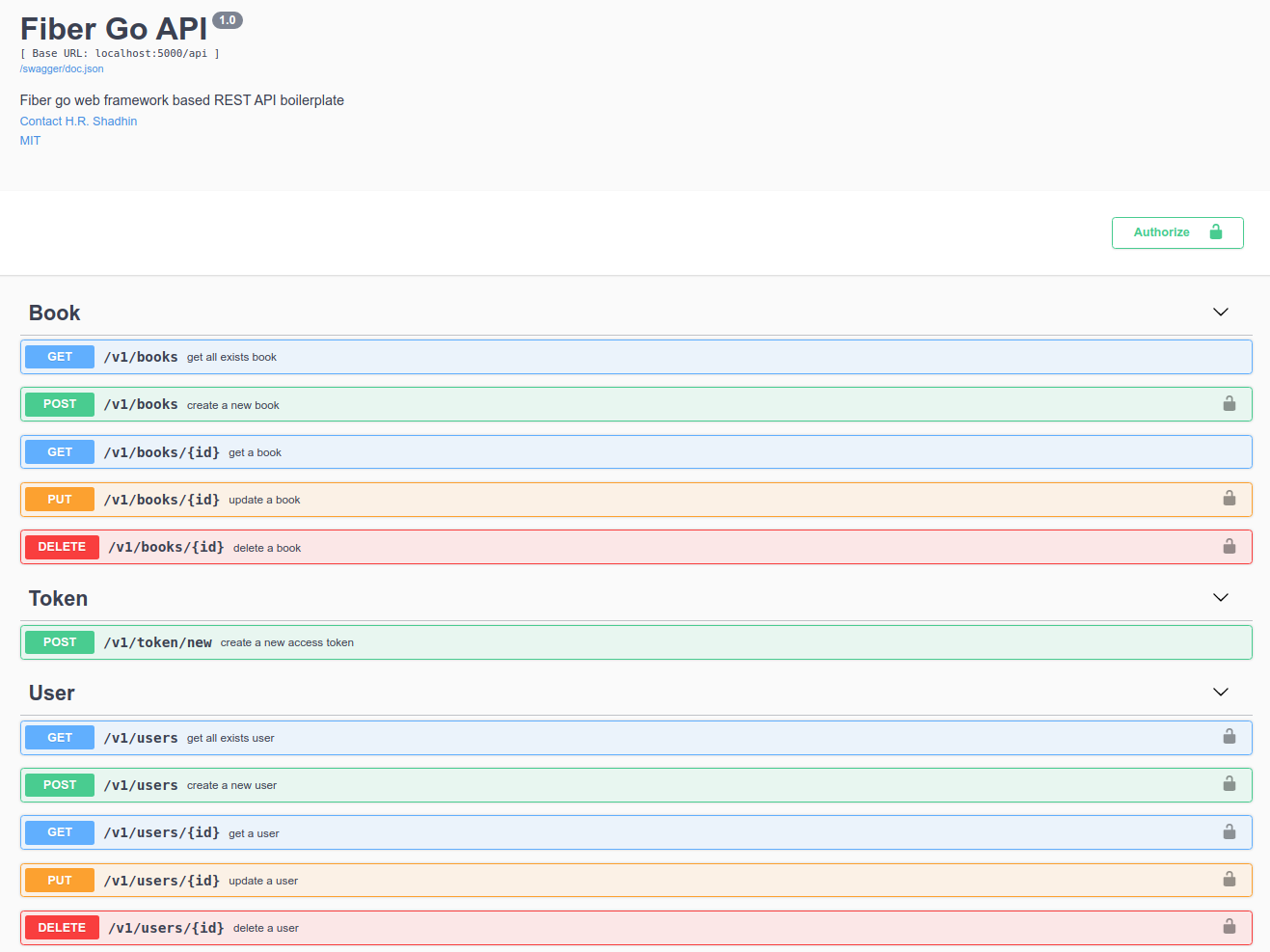Is a production-ready golang based boilerplate application with Fiber Go web framework. For any fiber go application, just clone the repo & rename the application name.
Fiber is an Express.js inspired web framework build on top of Fasthttp, the fastest HTTP engine for Go. Designed to ease things up for fast development with zero memory allocation and performance in mind.
- Install
docker,golang-migrate&swag - Rename
.env.exampleto.env - Run project by this command:
make docker.run
- Visit
http://localhost:5000orhttp://localhost:5000/swagger/ - Stop
make docker.stop
| Name | Version | Type |
|---|---|---|
| gofiber/fiber | v2.7.1 |
core |
| gofiber/jwt | v2.2.1 |
middleware |
| arsmn/fiber-swagger | v2.6.0 |
middleware |
| stretchr/testify | v1.7.0 |
tests |
| dgrijalva/jwt-go | v3.2.2 |
auth |
| joho/godotenv | v1.3.0 |
config |
| jmoiron/sqlx | v1.3.3 |
database |
| jackc/pgx | v4.11.0 |
database |
| sirupsen/logrus | v1.8.1 |
logging |
| swaggo/swag | v1.7.0 |
utils |
| google/uuid | v1.2.0 |
utils |
| go-playground/validator | v10.5.0 |
utils |
Folder with business logic only. This directory doesn't care about what database driver you're using.
/app/controllerfolder for functional controller (used in routes)/app/dtoData Transfer Objects(DTO) folder for transform data before sent to API clients/app/modelfolder for describe business models and methods of your project/app/repositoryfolder for perform database operations for models of your project
Main applications for this project.
The directory name for each application should match the name of the executable you want to have (e.g., /cmd/server /cmd/cron).
Don't put a lot of code in the application directory. If you think the code can be imported and used in other projects,
then it should live in the /pkg directory.
Folder with API Documentation.
This directory contains config files for auto-generated API Docs by Swagger, screenshots and any other documents related to this project.
Folder with project-specific functionality. This directory contains all the project-specific code tailored only for your business use case.
/pkg/configfolder for configuration functions/pkg/middlewarefolder for add middleware (Fiber built-in and yours)/pkg/routefolder for describe routes of your project/pkg/validatorfolder with validation functions
Folder with platform-level logic. This directory contains all the platform-level logic that will build up the actual project, like setting up the database, logger instance and storing migrations, seeds(demo data).
/platform/databasefolder with database setup functions (by default, PostgreSQL)/platform/loggerfolder with better logger setup functions (by default, Logrus)/platform/migrationsfolder with migration files (used with golang-migrate/migrate tool)/platform/seedsfolder with demo data for application rapid setup. mostly sql scripts
# .env
# APP settings:
APP_HOST="0.0.0.0"
APP_PORT=5000
APP_READ_TIMEOUT=30
APP_DEBUG=false
# JWT settings:
JWT_SECRET_KEY="super_secret_here"
JWT_SECRET_KEY_EXPIRE_MINUTES_COUNT=120
# Database settings:
DB_HOST=fibergb-postgres
DB_PORT=5432
DB_USER=dev
DB_PASSWORD=dev
DB_NAME=fiber_go_api
DB_SSL_MODE=disable
DB_DEBUG=true
DB_MAX_OPEN_CONNECTIONS=3
DB_MAX_IDLE_CONNECTIONS=1
DB_MAX_LIFETIME_CONNECTIONS=10- Install
docker,docker-compose&golang-migrate - Rename
.env.exampleto.env - Start db container
docker-compose up db - Run migrations
make migrate.up - Now start api server with hot reloading
make docker.dev - Visit
http://localhost:5000orhttp://localhost:5000/swagger/
- Install
PostgreSQLgolang >= 1.16golang-migrategosec&swag - Rename
.env.exampleto.envand fill it with your environment values - Migrate db & seed some demo data
make migrate.up make seed
- Run project by this command:
make run
- Visit
http://localhost:5000orhttp://localhost:5000/swagger/ - Check
Makefilefor more commands# drop migration make migrate.down # force migration to specific version migrate.force # run test make test ...






